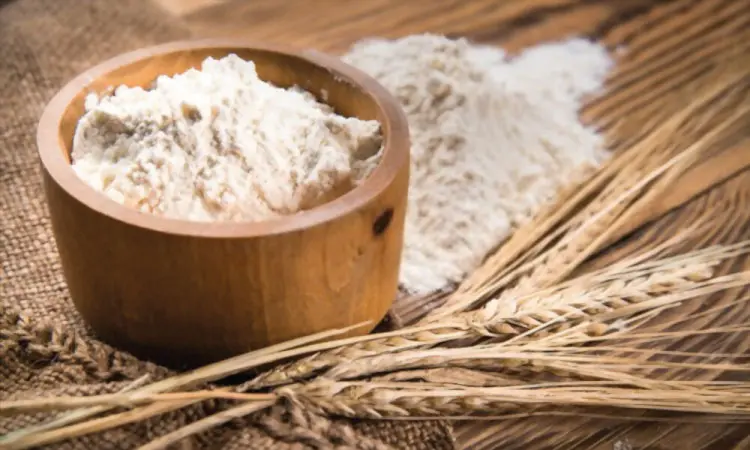Pregnancy is a time to have healthy and nutritious food. Though one can have cravings, it is not advisable to eat foods and food items made with maida or white flour. But no matter how much you may try, someone or the other will offer you maida during pregnancy.
Commonly used in food items like burgers, pizzas, cakes, etc. , it is unlikely to avoid it completely. We cannot eliminate its usage, but controlling it is in our hands. Pregnancy is a time when we need to be cautious and vigilant about what the pregnant woman is eating. It is even referred to as “white poison” as it keeps drastically affecting our health. Since it is not good for the health, let us have a look at the pros and cons of having maida during pregnancy.
What Is Maida?
Maida is made from the inner portion of wheat grains. The wheat flour is processed to a very high degree of purity. Many beneficial elements are lost during the maida production process.
In order to get its characteristic white hue and fluffy texture, maida is bleached and treated with chemicals. The bleaching substance employed in this process is very hazardous. Most of the wheat fiber is removed during the milling process, reducing the nutritional value of the resulting maida flour to nearly nothing.
Yet, maida is widely used especially during the festivities. Given its versatility, it is occasionally sold under the name “all-purpose flour.” Even though consuming maida during pregnancy is not very good for the health, it is still popular.
Related Reading: Craving Ice While Pregnant: Good Or Bad
Is Eating Maida During Pregnancy Safe?
Three components make up a grain of whole wheat: the bran, which is rich in fibers and anti-oxidants; the germ, which is rich in minerals and proteins; and, finally, the endosperm, which is rich in carbs. The bran and germ of the wheat are separated during the milling process that produces white flour. In actuality, maida is composed of nothing more than the endosperm.
Most maida-based foods are delicious, yet they have negative effects on our bodies. So is eating maida safe during pregnancy? Well, having food made of maida is NOT recommended during pregnancy, as it can lead to several health issues. It can even result in unhealthy weight gain. Having raw flour in any form during pregnancy is not a good option. Even having a maida paratha during pregnancy is not advisable.
Calculate Due Date With LMP
5 Reasons To Avoid Maida During Pregnancy
Consuming excessive amounts of maida has serious consequences. Obesity, type 2 diabetes, high cholesterol, and hypertension are only a few of the chronic disorders that may result. Health problems, including headaches and body pain, are other possible side effects.
Consuming maida during pregnancy is a strict no, but it is equally important to understand what makes maida an unhealthy option.
Five reasons to avoid the very versatile and popular all-purpose flour during pregnancy are as follows:
1. Hinders digestion
Maida has no fibers. Fibers aid in the removal of food material from your stomach. Carbohydrates alone cannot do this. Eating maida during pregnancy can interfere with bowel movements and even affect the rate of metabolism, which can result in constipation. It can even hinder the digestion process1.
Maida is sometimes referred to as “glue to the gut.” This is because, once in the digestive system, maida transforms into a glue-like sticky substance that might block the system. Furthermore, maida inhibits the formation of beneficial bacteria and affects the digestive process.
2. High chances of obesity
Maida has a high glycaemic index, which indicates it has almost double the calories when compared with foods that have a low GI (glycaemic index) or foods that are unprocessed. The body cells get more glucose when the calorie intake is high, which can turn into fat, resulting in rapid weight gain2.
Maida also changes the rate of metabolism3. This means that it slows down metabolism, makes digestion harder, and keeps hunger going for a long time. This causes weight gain, which, if continued for a long enough period of time, could lead to obesity.
Related Reading: Can A Pregnant Woman Eat Pizza?
3. Increased risk of chronic diseases
Since maida flour has an acidic character, it might cause the body’s calcium levels to drop, which can lead to chronic heart disease. Blood sugar levels may increase as a consequence of eating too much maida.
Obesity may also raise triglyceride levels, which can lead to cardiac problems. Having maida may even cause bad cholesterol to increase, which may lead to artery blockages and high blood pressure. Even the body’s immune system may become compromised. Its poor mineral content causes headaches, irritation, and acidity4.
4. The danger of developing diabetes
Insulin levels go up quickly and dramatically, which is one of the maida’s worst side effects. It has a high glycemic index, which is linked to the onset of inflammation and type 2 diabetes. Due to its high glycemic index, maida causes a rapid increase in blood sugar.
If a pregnant woman has diabetes or is at risk of getting gestational diabetes, she should limit the amount of maida she consumes. Pasta, pizza, and other processed foods should be avoided at all costs. Instead, you should eat whole grains and foods with a lot of fiber5.
5. Maida is nutrient deficient
The foods prepared with maida are undoubtedly very delicious. Having maida bread during pregnancy will only offer empty calories and result in making the person undernourished. When maida is processed, all the nutrients, proteins, and vitamins get destroyed. Having foods rich in maida also helps drain the vitamins and other nutrients from the body for better absorption. During pregnancy, nutritional needs must not be compromised6.
Side Effects Of Eating Maida During Pregnancy

Maida flour is superior to other wheat by-products in terms of flavor and versatility. That’s why you’ll find maida in so many baked goods and fast food joints. While maida may be used to make a wide variety of delicious dishes, it doesn’t have much to offer in the way of nutrients. The only thing maida provides are empty calories; it’s devoid of any real nutrition.
They leave you feeling weak and hungry and do little to benefit your health. Also, it is rather difficult to digest maida when compared with other flours. It is, however, not recommended to have food made out of maida during pregnancy.
Related Reading: 9 Things To Do When You Don’t Feel Like Eating During Pregnancy
Some side effects of this flour that emphasize why not to eat maida during pregnancy are as given:
1. Neurological disorders
Maida’s high glycaemic diet causes insulin resistance, which in turn increases her risk of developing cognitive issues including attention deficit hyperactivity disorder, sleepiness, weak memory recall, etc. It also increases the risk of developing Parkinson’s disease and Alzheimer’s7.
2. Anxiety and depression
It is best to avoid having maida during pregnancy, as it increases the risk of depression or increases the intensity of mood swings. According to research, there is a direct link between depression and the consumption of white flour8.
A healthy diet is a good way to keep depression at bay, so it is advisable to have fish, vegetables, and fruits9.
3. Chronic Illness
Due to the acidic nature of maida, eating it might cause the body to pull calcium from the bones in order to balance out the pH. Bone density suffers as a result of efforts made to neutralize the additional acid. An excess of acid in the body is a primary contributor to degenerative diseases, including arthritis, migraines, and headaches10.
4. Acne
Acne is common among pregnant women. It occurs more often during the first and second trimesters. The most probable cause is an overproduction of oil (sebum), which occurs when the body generates more of certain hormones. Consuming refined carbohydrates may increase insulin secretion, increasing the risk of skin irritation and breakouts11.
Related Reading: 11 Easy Tips Glowing Skin During Pregnancy
5. Cancer
It’s no secret that eating well is one of the best ways to maintain your health and stave off a variety of potentially debilitating illnesses. Furthermore, a balanced diet may delay or even prevent the development of cancer, as any oncologist or cancer expert can attest to. White bread and other meals made with refined grains like white flour may raise blood sugar and cause insulin resistance. Among other malignancies, this may increase your chance of developing colon and kidney cancer12.
6. It has harmful chemicals
Wheat has two parts: the exterior shell, which is edible, and the inner, which is not. The interior section is also devoid of fiber. This portion was ground and bleached using benzoic peroxide to produce a white powder. This one was combined with Alloxen (a chemical) to produce Maida. This risky chemical procedure is why Maida is so soft and white in color.
It is important to know that Alloxen is predominantly used in the testing of insulin in rats and pigs. Scientists frequently inject this substance into animals to make them diabetic so that they can be used to test treatments. Similarly, in the fabric mill sector, Benzoic peroxide is utilized to provide a pure white color. Unfortunately, these chemicals are one of the major inputs for maida production13.
Related Reading: 11 Tips For Balancing Work And Motherhood
7. Decreases bone density
The pH of maida is quite low. When you take it in excess, your body must pull calcium from your bones and teeth to neutralize the excess acid14. This results in the release of alkali from your bones, which causes your bone density to go down in the long run. It’s already risky to be deficient in calcium during pregnancy, but consuming maida can make it worse.
8. May weaken immunity
As is well-known, maida can wreak havoc on the digestive system, but it may also put a strain on the adrenal glands. One of the foods that contribute to adrenal fatigue is maida15. Overconsumption of maida-based foods is the only way this could happen, and it can significantly lower the body’s resistance to disease16.
Safe Alternatives To Maida

For better health, it is best to avoid white flour or maida. There are three ways: either stop its consumption or limit the intake as far as possible. The third one is more acceptable. use There are a few alternatives to white flour which are given as under:
- Whole wheat flour- Whole wheat flour is richer than white flour. It is made from the complete wheat grain, which comprises the outer coating or the bran or the nutrient center called the germ. Whole wheat flour can retain much more nutrients in the process of production
- Ragi flour – Another great alternative to maida is ragi flour. This flour has a good combination of calcium, protein, iron, dietary fiber, antioxidants, etc. It is good for weight control and diabetic people since it can keep one full for a longer time. It is light to digest and even gluten-free. It can be taken separately or by mixing with other flours
- Bajra flour- Bajra is commonly consumed in northern parts of the country and is a great alternative to maida. This flour is packed with carbs, amino acids, calcium, antioxidants, phosphorus, etc. The flour is good for regulating blood sugar levels, promoting heart health, and even regulating blood pressure levels
- Jowar flour- It is a great alternative to maida. And jowar flour can easily be mixed with whole wheat flour to prepare the batter or dough. Jowar is a good iron, fiber, calcium, protein, phosphorus, vitamins, and antioxidants source
- Buckwheat or Kuttu flour- Buckwheat flour is gluten-free and can be added to the regular diet as well. It is nutrient rich as it contains minerals like copper, magnesium, manganese, and vitamin B
- Soy flour- Soy or soya is another healthy alternative to maida, It is an excellent source of calcium, proteins, vitamins, folate, iron, manganese, zinc, etc.
- Urad flour- Urad flour is prepared by grinding the skimmed gram lentils also known as urad dal. This dal is gluten-free nutrient-rich and rich in dietary fiber. This flour is even referred to as the king of cereals as it is highly used for medicines as well as nutritional value
Apart from the above-mentioned ones, a few others are:
- Gram flour or Besan
- Rice flour
According to Our Nutritionist, Sushree, almost all the nutrients are lost during the processing of Maida and are also bleached with various chemicals like benzoyl peroxide while processing that is harmful for the mother and the growing fetus. They are high in glycemic index and easily spikes up your glucose level causing gestational diabetes. It raises your bad cholesterol that results in weight gain(obesity) which will lead to several lifestyle diseases like cardiovascular disease, hypertension. It is also acidic in nature that are used in making refined and processed products that leads to inflammation, digestive issues and weight gain. Many research have also shown higher risk of overweight babies in their later growing stage. Therefore you should always make a healthy choice for you and your growing baby, eliminate processed refined flour from your diet, and include various whole grains, millets to your diet which contains various essential nutrients that will help in the development of baby.


